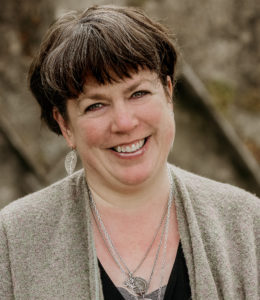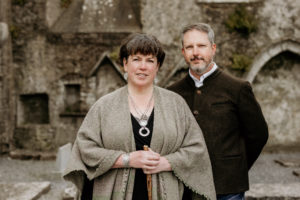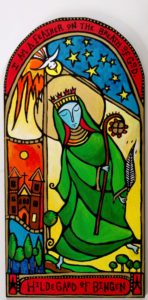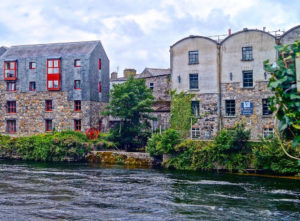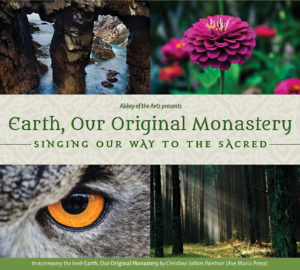Christine Valters Paintner, PhD is the online Abbess of Abbey of the Arts, a virtual monastery and global, ecumenical community. In 2012, Christine and her husband John left their home in the U.S. and moved to Ireland, where they now lead pilgrimages, retreats and classes, integrating contemplative practices and creative expression. We recently had a delightful talk with this Benedictine oblate, spiritual director, author, poet and teacher, and learned more about her intriguing story.
Here are a few audio highlights from our conversation, with traditional Irish music by Aislinn. (2:22)
Interview by Laura Locke
Kolbe Times: Can you tell us a little about your early life?
Christine Valters Paintner: I was born in Manhattan and I grew up in New York City. My father worked for the United Nations. He was an Austrian citizen. I actually have dual U.S. and Austrian citizenship myself, through him, which is part of what helped my husband and I move to Europe eventually. I went to the United Nations International School when I was growing up, from kindergarten through high school — which was a really great place to learn and have friends from all over the world.
My parents weren’t religious people at all. In fact, my father was fairly hostile to religion for a long period of time in my life. But my parents had a great love of museums and sacred architecture, and we traveled quite a bit since my father worked for the UN. And because he was from Austria, we would go back there summers, and travel in Europe quite a bit and visit all these wonderful museums and cathedrals. I sort of feel like that aesthetic exposure early on in my life was my connection to the holy. Plus, I’ve always had a seeking heart, I think.
Kolbe Times: You wrote somewhere that your roots were in the Catholic tradition. Can you expand on what you mean by that?
Christine Valters Paintner: One of my grandparents was Catholic — my father’s mother. Each of my grandparents were actually from a different denomination. But my paternal grandmother was Catholic. She was dying of cancer when I was born, and my parents had me baptized in the Catholic Church — I think in part to please her and make her happy. So it’s interesting because I wasn’t raised as a Catholic by my family, but when I was about seven years old one of my best friends was Catholic, and I’d go to church with her. And so I did receive the sacraments of initiation, although it didn’t mean a lot to me at the time because I didn’t have the family context for it. But then later I went to Fordham University, which is a Jesuit university in New York, and that was the place where I was able to start giving language to my longings from my experience. So I felt that initiated me into this Catholic mystical and prophetic tradition that I love — which I’d been technically a part of all those years before, but hadn’t really had a way to engage. So I feel like I snuck in the back door! I mean, I have loads of issues with the institutional church — and that would be a whole long discussion on its own — but I have a deep, deep love for a lot of the practices and the mystics and the communion of saints. All of that very much informs my work.
Our community, Abbey of the Arts, is meant to be ecumenical, and we also have people who aren’t of any religious background at all, which is great. We like to feel rooted in that tradition, but keep a very spacious, welcoming space.
Kolbe Times: How did you meet your husband, John?
Christine Valters Paintner: Interestingly, he was raised very Catholic from the get go. John’s mother was actually a Benedictine nun, though she didn’t take her final vows. It was around the time of Vatican II, and she met John’s father and left the Order. They actually met in the same church where John and I later were married, in Sacramento, California. But I’m getting ahead of my story! After college, I did a year with the Jesuit Volunteer Corps. I went from New York to Sacramento, which was where my placement was. I was trying to get as far away from home as possible at the time.
During my volunteer year I hadn’t met John yet. But I lived in community with a number of women during that year, and we all stayed on living together in Sacramento, in community, for another couple of years. During my second year in California I worked a number of different jobs — at a homeless shelter and at a group home for emotionally disturbed teens, and I also had a part time job at a Newman Center at Sacramento State University. One of my jobs there was cooking the Wednesday night Fellowship Dinner for the young adults. That’s where John and I got to know each other. He was on the Retreat Team, and we went on retreat together a couple of times. It was very sweet. We were friends first — and I remember the night when we saw each other and kind of thought, “Oh, maybe there’s something more here!” We’ve now been married for 25 years, so I guess we were on the right track.
Kolbe Times: It sounds like you were! You did your PhD at the Graduate Theological Union in Berkeley, in Christian Spirituality. Tell us a bit about that experience.
Christine Valters Paintner: I had done my Masters in Systematic Theology, and at that point I was doing a lot of ministry in spiritual direction and retreat work. I had always felt called to some sort of academic path and study, but I didn’t like the abstractness of Systematic Theology as much as I thought I might. The Christian Spirituality program was a good fit for me, because it was more about the experience of the Divine, as opposed to the dogmas and the ways of thinking about them.
Kolbe Times: And it was during your time in the San Francisco area that you learned more about the field of expressive arts therapy.
Christine Valters Paintner: Yes, exactly. It was wonderful because that’s really where the whole idea of expressive arts therapy was founded, and I was blessed to learn more about it while I was living there. I had already been integrating arts into my retreat work and spiritual direction, but I felt that all of a sudden I had this language for engaging with the arts as ‘process over product’. This is a way of thinking about creative expression as perhaps a prayer practice, as mediation, as a process of discovery – as opposed to being focused on creating a fine art product, which of course has its own place but is a completely different kind of impulse, I think.
Kolbe Times: And this is also when you encountered Hildegard of Bingen, which was another big discovery for you. I’ve read a little about her, and I know she lived in Germany in the 12th century and was a Benedictine Abbess and mystic, who was also into composing music, and studying botany and medicine, and writing dramas and poetry…an amazing, amazing woman.
Christine Valters Paintner: Yes! I learned about her when I was studying for the History of Christian Spirituality exam, and I fell in love with her because of the way she brought together the creative and the contemplative. She was actually my doorway into the Benedictine path, because I wanted to find out more about the Benedictine Rule that shaped her life. So she introduced me to St. Benedict, and that led me to becoming a Benedictine oblate. It’s a really important part of my life — so yes, I have a great, great love of Hildegard. We lead pilgrimages in Germany every couple of years, and I love being in that space and that landscape that shaped her.
Kolbe Times: So after graduate school, you and John moved to Seattle.
Christine Valters Paintner: That’s right. We had actually visited a friend in Seattle the year before we finished graduate school, and just fell in love with the area. We also discovered that it was much more affordable to live in Seattle than in the Bay area, and that we could actually buy a home there. We decided that if one of us could get a job in Seattle, we would move there. Well, we both ended up getting hired! John worked full time at a Catholic Boys High School for the whole time we lived there, and I started out working as an Adjunct at Seattle University, which is a Jesuit university. I did that for the first few years until I realized that academic life actually isn’t what I really wanted out of my life. But it was a great place to be at the time. Seattle is a wonderful city, and we made lots of good friends there.
Kolbe Times: And it was in Seattle that you made another important discovery – another piece of the puzzle, as it were – which was getting more in touch with the wisdom of the body. Tell us about that.
Christine Valters Paintner: Yes, I had a wonderful yoga community there. It actually doesn’t exist anymore, sadly. It was called the Samarya Center – “samarya” is a Sanskrit word meaning “community”. It was founded by a wonderful woman named Molly Lannon Kenny — who actually lives down in Mexico now — she was a yoga therapist. It was in the central district in Seattle, so it was in a more low-income area. The first time I looked at their website I actually cried because they had photos of bodies that were not just like the typical white, slender, toned yoga bodies! There were pictures of all different kinds of bodies and ethnicities and ages and genders. It was clear that they were making a welcoming space, just by their initial presence to people. I started practicing there and it was clear that what they put forth on their website was everything that they embodied. And they also took yoga seriously as a philosophy, so my own theological, philosophical heart felt very satisfied engaging with some of that. I eventually went on to do their teacher training – not so much because I wanted to teach yoga, although I have done some yoga teaching as part of our retreats. Mostly it was because I wanted the opportunity to go a little bit deeper, so I’m really grateful for that opportunity.
Kolbe Times: So many people, including myself, have not really been in touch with our bodies in a nurturing, positive way for most of our lives – if we’re in touch with them at all. So it’s a new revelation when we start that process. You wrote a book a few years ago called The Wisdom of the Body: A Contemplative Journey to Wholeness for Women. It’s a much-needed read for many of us.
Christine Valters Paintner: Thank you. In that book I quote Reginald Ray, who is a Buddhist teacher. He says, “The body is the last unexplored wilderness.” That quote really resonated with me as someone who loves the desert tradition; the monks going out into the wilderness to have a radical encounter with God, at the edges of their discomfort. When I read Ray’s quote, I thought, ‘Yeah, that’s exactly it – particularly in our modern culture.’
I’ve had rheumatoid arthritis since I was 21, so I’ve had it almost 30 years now. I’ve gone through lots of different seasons with it, some easier than others, on many different levels. In many ways it’s been a really great teacher and guide, to help me descend into my body. Yoga has been a big help in that as well, because there are certainly ways when we’re in physical pain where we might disconnect from our bodies as well. I don’t necessarily take it for granted that illness would offer us that entry point. But for me, that has been the case, and yoga has been a way to be with my body and its vulnerability in a loving, compassionate way. And I think that particularly my involvement at the Samarya Center helped me to be more open to how the body offers its wisdom – no matter what its condition. You don’t have to be healthy and fit to have this really deep relationship with your body. I also think that as a writer, I’ve discovered how having a movement practice really enriches my writing, because it gets me out of my head and helps me drop down into this more intuitive place. I’m grateful for that, too.
Kolbe Times: It strikes me, as you speak about this, that as we age it’s good for us to fall in love with our bodies in a new way.
Christine Valters Paintner: Hopefully as we age, we can start to shed some of the cultural expectations that we might bring around aging, around beauty, around all of those kinds of things that, you know, maybe set us on cycles of self-judgment and consumerism that aren’t necessarily very healthy or life giving…and maybe down a new path.
Kolbe Times: I was fascinated to hear about your decision, after being in Seattle for nine years, to suddenly embark on this grand adventure of moving to Europe. You basically sold everything you owned! I’d love to hear what sparked that decision, and about your journey which ultimately took you to Galway, Ireland.
Christine Valters Paintner: It was actually sort of a slow process. Because John was teaching high school and I was teaching university, we had the summers off and so we started traveling to Europe together on our summer breaks. Ireland was actually the first place we visited together in Europe. And because both my parents had passed away, I was starting to do a lot of ancestor work – exploring connection to family systems and lineage, and appreciating where I’m from. We started making what I call ‘ancestral pilgrimages’, and we visited Germany and Austria for me, and Latvia, UK, Ireland, all these places. We started to go to Europe every summer, and then we started to go at Christmas time as well!
At that point we had filed the paperwork to get my Australian citizenship back — the U.S. frowned on that kind of thing for a while, but they had since changed their policy. So when I finally got my Austrian passport, we were thinking about going on sabbatical. But my husband had a new principal at his school who wasn’t so keen on letting him take time off and hold onto his job. Then one day my husband came home from a Religion Department staff meeting, in which they were told that their entire curriculum was changing because the Catholic Bishops were instituting a standardized curriculum across all Diocesan Catholic schools. The one thing that was keeping John there at the school was teaching Hebrew Scriptures, because he loved the storytelling. He loved that he didn’t have to teach doctrine and dogma and all of that – he could share his love of story. And largely, the new curriculum was eliminating a lot of that engagement, particularly with the Hebrew Scriptures, which was really unfortunate. So he came home from work that day – and we joke about it now, because my eyes lit up! I knew that this was the doorway, because it now seemed that there wasn’t even any point in his staying on at the school. We’d already talked about the sabbatical, so I started thinking, “Let’s do this!”
It took John a couple weeks, but ultimately he came around very wholeheartedly. We decided to sell our home because we wanted to have freedom to see where the journey would take us. We sold our car and most of our belongings and even our books! I know a lot of people cringe when they hear that, but luckily I had a friend in Seattle who owned some bookstores, so she took a lot of them. Basically, we just had a couple of big suitcases! We put a few pieces of family furniture and lots of family photos in a storage locker, but they stayed in storage for a couple of years while we were finding our feet. We traveled to the east coast, and then we took the Queen Mary across the Atlantic because we’d always wanted to travel by ocean liner, just to see what it was like. That was a beautiful part of our arrival in Europe – that slow unfolding.
We ended up in Vienna to begin with because I had always wanted to live there. I had spent a lot of time there as a child and my father is buried there. It’s a city that I have a great love and affection for. It was beautiful to live there, but it was also challenging in lots of ways. We had to apply for my husband’s residency card, and there was so much bureaucracy. Because I was self-employed, and in a way that they didn’t quite understand, it was very complicated. We kept running into roadblocks. So ultimately, after six months, we were told that John would have to leave the country until they decided, and we didn’t know at that point what the decision would be. Ireland was always ‘Plan B’ for us, so to speak, and so that’s where we went – and we ended up living in Galway!
Kolbe Times: What drew you to Galway in particular?
Christine Valters Paintner: A lot of people ask us how we ended up here, and I honestly don’t have a very clear answer other than Dublin was too big.
But I will say this: I loved being on the west coast of Ireland – the wild west coast, and the Atlantic Ocean, and that sense of being on the edges of things. It’s also an incredible arts community, and that has been a real gift to us. I think we knew it was an arts community, but we didn’t quite know how much that would nourish us, and particularly John, who has had a great interest in Theatre and Film for many years. Those two art forms in particular have really thriving communities here that he’s plugged into.
Kolbe Times: And the poetry community there has been important for you.
Christine Valters Paintner: Yes, that’s really true. There’s a wonderful couple here that are very good friends of ours, and they run a number of poetry classes and they do readings a couple times a month. They are very much at the heart of the poetry community here in Galway. On Thursday afternoons there is a poetry class that is a very vibrant group of people. I’ve always had a love of poetry and had written poetry in the past, but here in Galway I received the encouragement and the support that I needed to take it to another level – and to take it more seriously as a craft.
Kolbe Times: It’s so inspiring the way you and John took this leap, and ended up in Galway – and it’s great to hear how you’ve enjoyed and obviously really benefited from getting involved in the community there. I’m sure exploring the rich history and spirituality in Ireland must also have felt like a gift.
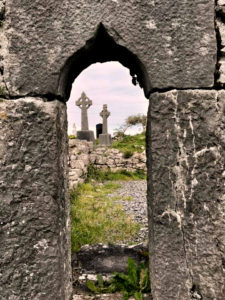 Christine Valters Paintner: Oh yes. There are so many sacred ruins within just an hour of where we live. The whole country is just saturated with old churches and stone circles and forts and passage tombs. When we first got here, we’d meet people and they’d find out about our theology background, and they’d say, “Oh, you really have to go see this place or this site, or meet this person.” We started visiting all these sacred sites, and that’s when we started to think that maybe we could lead a pilgrimage. We’d done a lot of retreat work in the past, but that first year in Galway we decided to offer a pilgrimage to some of these sites we’d been exploring. Well, I think it filled up in one day, so we thought, “Wow, there’s a hunger here.” It was a small group, and a slow pace, so a different sort of experience. That also has been a real gift: bringing people here, welcoming them, hiring guides who are friends with a love of the culture and the stories and the land here. Ireland has been very good to us on many levels. I’m very grateful.
Christine Valters Paintner: Oh yes. There are so many sacred ruins within just an hour of where we live. The whole country is just saturated with old churches and stone circles and forts and passage tombs. When we first got here, we’d meet people and they’d find out about our theology background, and they’d say, “Oh, you really have to go see this place or this site, or meet this person.” We started visiting all these sacred sites, and that’s when we started to think that maybe we could lead a pilgrimage. We’d done a lot of retreat work in the past, but that first year in Galway we decided to offer a pilgrimage to some of these sites we’d been exploring. Well, I think it filled up in one day, so we thought, “Wow, there’s a hunger here.” It was a small group, and a slow pace, so a different sort of experience. That also has been a real gift: bringing people here, welcoming them, hiring guides who are friends with a love of the culture and the stories and the land here. Ireland has been very good to us on many levels. I’m very grateful.
Kolbe Times: That’s wonderful. Here in Calgary, where we live, if a building is over 100 years old, we’re impressed.
Christine Valters Paintner: I know. It’s such a different perspective on time here. The Christian ruins are anywhere up to 1500 or 1600 years old. And when you look at the passage tombs, which are these ancient burial chambers, they are, like, 5000 years old…which is older than the Egyptian pyramids. It’s amazing.
Kolbe Times: So when you moved to Galway, was that the birth of Abbey of the Arts?
Christine Valters Paintner: Actually I started Abbey of the Arts when I lived in Seattle. It started as a blog in about 2006, a few years after graduating with my PhD. The original blog was called The Sacred Art of Living. Writing was always my first love – I went to graduate school, in part, because I thought it would make me a better writer. Well, it made me very much an academic writer, which isn’t necessarily what I wanted to do! At the time, blogging was just beginning, in terms of its popularity, and I thought this would be a great way to try to train myself to write short posts, geared towards a general audience of people. I made a lot of new friends – virtual friends – through that experience. After a year of doing the blog, the name “Abbey of the Arts” just came to me. It was an expression of my love for this monk contemplative path, and also my love for creative expression. Soon after changing the name, we started offering online retreats. An online monastery and community wasn’t really in our consciousness at that point, or what I was initially intending – but that’s definitely what it’s become. And moving to Ireland, and John letting go of teaching high school and wanting a break from that, has meant that he is now my partner in this ministry. Up until the time we moved here it was really more my work, but now he brings his gifts to what we do – to both some of the online and live retreats. That’s been great. We’ve had our growing moments, learning how to work together…but yeah, I love it.
Kolbe Times: For our readers, how would you describe Abbey for the Arts now?
Christine Valters Paintner: It’s a virtual global community, an online monastery. Its purpose is to integrate contemplative practice and creative expression. We offer resources, reflections, online retreats, live pilgrimages and retreats…but we also produce CDs. We’ve done three albums already of compilations of songs, and each one has accompanied a book that I’ve written. I have a wonderful teaching partner named Betsey Beckman, whom I met in Seattle, and we’ve been teaching together ever since then, and we still teach together now, which is great. She is a dancer, and her husband is a musician, so she kind of spearheads the music production side of things. She also creates videos that feature dances to go with these songs. That’s where the ‘dancing monks’ image comes from, which also springs from my own love of movement and dance as part of this contemplative practice. We invite anyone who wants to affiliate with our community and who has a desire to live into the monk and artist path more fully to join our Holy Disorder of Dancing Monks.
We’ve worked with a number of artists, such as Marcy Hall in Pennsylvania. She’s created a whole series of dancing monk icons – 25 of them. We have a Wisdom Council of 15 people as well, so that it’s not just John and I trying to figure everything out. The Abbey of the Arts is very much a community, and a collaborative effort, and I love that aspect of it. I wrote a poem, you know, a couple years ago that I passed on to a musician friend, and then he created a song from that – and then we worked with a local filmmaker here in Galway, and he created a video for that. So that kind of collaborative effort I really love, and I find very enlivening.
Kolbe Times: Your website is very rich in resources and information about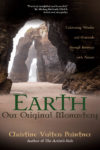
all the things you offer, may I add. It’s wonderful just scrolling through it and getting immersed in it. You’ve also found time to write thirteen books – with one just published in April 2020, called Earth, Our Original Monastery: Cultivating Wonder and Gratitude Through Intimacy in Nature published by Sorin Books at Ave Maria Press. Tell us a bit about that.
Christine Valters Paintner: It’s about cultivating this Earth-cherishing relationship in deeper ways. In the book I talk about having a revolution of love, and how we need to fall more in love with Earth.
Kolbe Times: And there’s also a companion CD of music as well, with 12 songs inspired by the book. I recently watched a video on your website – a “virtual launch” of the book and the album. I believe Betsey Beckman, whom you mentioned earlier, was on the video, as well as two wonderful musicians, Richard Bruxvoort Colligan and Simon De Voil. They performed on the video, and they are two of the musicians featured on the album, I believe.
Christine Valters Paintner: Yes, that’s right. The virtual launch was great fun. The album is called Earth, Our Original Monastery: Singing our Way to the Sacred. I also have a poetry book coming out in October 2020, from Paraclete Press. It’s called The Wisdom of Wild Grace, and it came out of the experience of writing The Earth, Our Original Monastery and wanting the more poetic expression of that.
Kolbe Times: Sounds interesting. Tell us more about The Wisdom of Wild Grace.
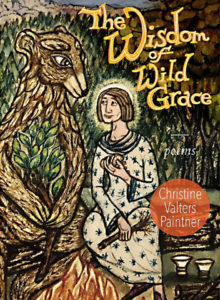 Christine Valters Paintner: Well, I’ve always had this love of the stories that come largely out of the desert and Celtic tradition, of the intimacy and connection between saints and animals. There’s an old book by Helen Waddell called Beasts and Saints. It’s really lovely, and has images of wood cuts in it, and she tells all these stories that she’s compiled. I started a project of writing poems to go with some of these stories and then I started to do research. St. Benedict had this encounter with a raven; St. Francis had an encounter with a wolf and a grasshopper; St. Julian with a cat. There’s also some of the later medieval saints. I ended up writing a series of about 30 poems that explore each of these stories. And that doesn’t even touch the whole body of that work, but those are the ones that really called to me. The whole collection has probably about 75 poems all together, exploring this idea of wildness…which for me, is sort of this idea of what happens when we allow ourselves to expand beyond the patterns and the habits and the entrenched ways of being in our lives that limit our vision in ways that we often aren’t even aware of. And so you know, coming on pilgrimage, disrupting our lives and moving to Ireland is part of that process – although you don’t have to do that necessarily to welcome wildness into your life – but anything that helps move you to a place where you start to disrupt your usual ways of being in the world. I’m kind of intrigued by that idea of wildness.
Christine Valters Paintner: Well, I’ve always had this love of the stories that come largely out of the desert and Celtic tradition, of the intimacy and connection between saints and animals. There’s an old book by Helen Waddell called Beasts and Saints. It’s really lovely, and has images of wood cuts in it, and she tells all these stories that she’s compiled. I started a project of writing poems to go with some of these stories and then I started to do research. St. Benedict had this encounter with a raven; St. Francis had an encounter with a wolf and a grasshopper; St. Julian with a cat. There’s also some of the later medieval saints. I ended up writing a series of about 30 poems that explore each of these stories. And that doesn’t even touch the whole body of that work, but those are the ones that really called to me. The whole collection has probably about 75 poems all together, exploring this idea of wildness…which for me, is sort of this idea of what happens when we allow ourselves to expand beyond the patterns and the habits and the entrenched ways of being in our lives that limit our vision in ways that we often aren’t even aware of. And so you know, coming on pilgrimage, disrupting our lives and moving to Ireland is part of that process – although you don’t have to do that necessarily to welcome wildness into your life – but anything that helps move you to a place where you start to disrupt your usual ways of being in the world. I’m kind of intrigued by that idea of wildness.
I also commissioned an artist in the UK, David Hollington, and he did wonderful paintings of twelve of the animals and Saints stories, so they’ll be in The Wisdom of Wild Grace as well. I’m very excited about that.
Kolbe Times: Tell us about another recent collaboration of yours – the video of your poem Praise Song for the Pandemic. I’ve seen it around on social media and other platforms – it really seems to be striking a chord with many people.
Christine Valters Paintner: That was a lovely organic process because the poem came very spontaneously to me one morning, early in the pandemic, when things first started happening. It was one of those poems that came from somewhere beyond me. I had talked with Travis Reed — who is founder and filmmaker on The Work of the People website — about a year ago about doing some kind of collaboration, but because John and I were starting a sabbatical time, we decided to put it on hold. But then Travis contacted me and asked if he could put images to this poem I’d written, and I told him that would be great. I’m just delighted with what he did. And hopefully there might be more collaboration there as well.
Kolbe Times: Christine, thank you so much for spending time with us today. It’s been a joy to talk with you.
Christine Valters Paintner: Thank you. I’ve really enjoyed this as well.
PRAISE SONG FOR THE PANDEMIC – written and read by Christine Valters Paintner; music by Giants & Pilgrims:
Visit Abbey of the Arts website for more information, resources and upcoming programs. You can also follow them on Facebook.
To see more of Marcy Hall’s artwork, visit Rabbit Room Arts , or follow her on Facebook and Instagram.
Photos courtesy of Christine Valters Paintner and Elana Lenax.


